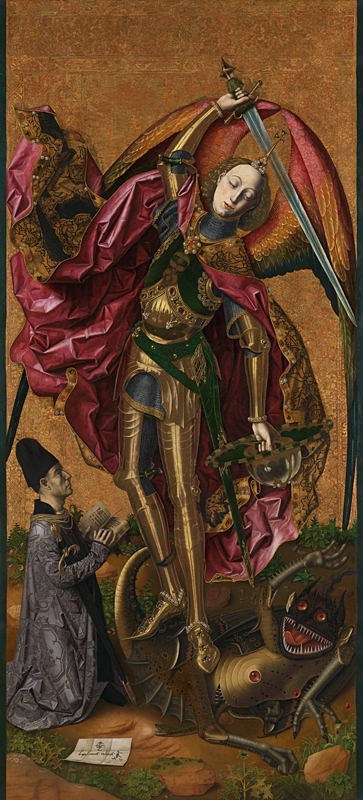SAINT MICHAEL TRIUMPHS OVER THE DEVIL
BY BARTOLOME BERMEJO
Last week I snuck out of my London office to see Francesco Melzi’s painting of Flora on loan to the National Gallery from the Hermitage. En route through the rooms of 16th-century Italian Renaissance art, trying hard to stay focused on my mission, I was waylaid by a knight in shining armour. This was the moment I first saw the arresting image of Bartolome Bermejo’s Saint Michael Triumphs Over the Devil.
The goddess of Springtime would have to wait …….
Dressed in golden armour richly adorned with jewels, the archangel descends from the heavens like a medieval superman with his voluminous red-lined cape floating down behind him. Having cast the angel Lucifer out of heaven, he pins him to the earth with his sword raised menacingly overhead. It is a powerful image.
As I looked more closely, the truly surreal nature of Lucifer’s portrayal became apparent reminding me of the grotesques in the works of Bermejo’s Flemish contemporaries Bosch and Bruegel. Shown as a monster, his limbs are a strange combination of fantastical creatures. His dragon wings crushed beneath the bejewelled feet of St. Michael carry the menacing eye spots of a butterfly’s underwing. His head, a gurning Cheshire cat with ferocious teeth and luminous red eyes, is almost comic. His eyes are reproduced in his golden breast plate, the only part of this creature which bears any resemblance to his once fellow angel.
Kneeling benignly to the left of the image is the painting’s patron, Antonio Juan. His face strangely unmoved by the presence of the divine and demonic.
But it is the face of Saint Michael, framed by his folding wings and the silver sword wielded overhead, that most disturbs. The pearl encrusted cross on top of his head shouts his heavenly status. His long, pale face with eyes lowered is devoid of emotion, detached and disdainful. There is no pity or compassion in this face: the once beautiful Lucifer, now portrayed as a grotesque beast, is sub-human and utterly unworthy of his sympathy.
This complex and alluring image is exquisitely painted – a celebration of man’s artistic genius but at the same time deeply unsettling. Typical of its time, the painting is a starkly two-dimensional understanding of humanity seen through the warped lens of religion – black and white, saint or sinner. Sadly, it is this same religious dogmatism that 21th-century man is often still plagued by.
Born Bartolome de Cardenas in Cordoba, Spain in 1440, there are only about twenty known works by him and this, dated 1468, is the first documented commission. Considered one of Spain’s greatest Renaissance artists, he seems largely un-acknowledged by academia. The National Gallery in London, like all major galleries, contains so many treasures and sometimes it is stumbling across a painting that was previously unknown to you that is the most rewarding.
* * *



